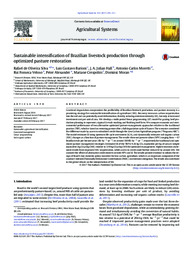Sustainable intensification of Brazilian livestock production through optimized pasture restoration.
Sustainable intensification of Brazilian livestock production through optimized pasture restoration.
Author(s): SILVA, R. de O.; BARIONI, L. G.; HALL, J. A. J; MORETTI, A. C.; VELOSO, R. F.; ALEXANDER, P.; CRESPOLINI, M.; MORAN, D.
Summary: Grassland degradation compromises the profitability of Brazilian livestock production, and pasture recovery is a promising strategy for sustainable intensification of agriculture (SAI). Recovery increases carbon sequestration into the soil and can potentially avoid deforestation; thereby reducing emissions intensity (EI), but only at increased investment cost per unit of area. We develop a multi-period linear programming (LP) model for grazing beef production planning to represent a typical Cerrado stocking and finishing beef farm. We compare economic and environmental performance of two alternative optimized pasture management approaches relative to the traditional practice (TRP), which is based on restoring pasture after a full degradation cycle of 8 years. The scenarios considered the difference made by access to subsidized credit through the Low Carbon Agriculture program (?Programa ABC?). The model estimates EI using upstream life cycle assessment (LCA), and dynamically estimates soil organic carbon (SOC) changes as a function of pasture management. The results show net present values (NPV) ranging from − 67 Brazilian reals per hectare-year (R$·ha− 1·yr− 1) to around 300 R$·ha− 1·yr− 1, respectively for traditional and optimized pasture management strategies. Estimated EI of the TRP is 9.26 kg CO2 equivalent per kg of carcass weight equivalent (kg CO2e/kg CWE) relative to 3.59 kg CO2e/kg CWE for optimized management. Highest emission abatement results from improved SOC sequestration, while access to credit could further reduce EI by around 20%. We consider the effects of alternative credit interest on both NPV and EI. The results provide evidence to inform the design of Brazil's key domestic policy incentive for low carbon agriculture, which is an important component of the country's Intended Nationally Determined Contributions (INDC) on emissions mitigation. The results also contribute to the global debate on the interpretation of SAI.
Publication year: 2017
Types of publication: Journal article
Observation
Some of Embrapa's publications are published as ePub files. To read them, use or download one of the following free software options to your computer or mobile device. Android: Google Play Books; IOS: iBooks; Windows and Linux: Calibre.
Access other publications
Access the Agricultural Research Database (BDPA) to consult Embrapa's full library collection and records.
Visit Embrapa Bookstore to purchase books and other publications sold by Embrapa.

